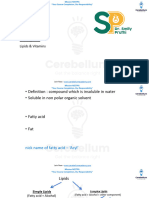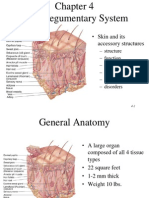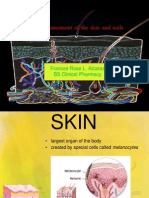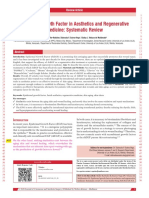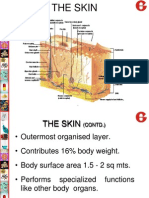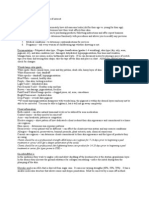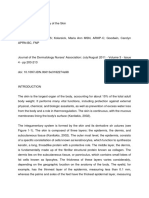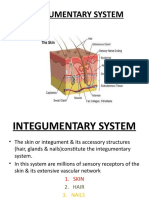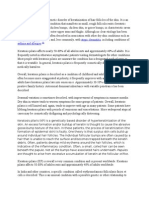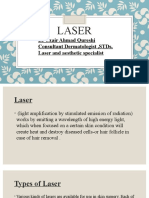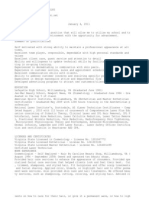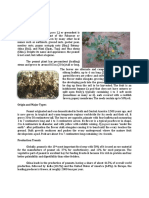Skin Functions and Layers
Skin Functions and Layers
Uploaded by
Anis Samrotul LathifahCopyright:
Available Formats
Skin Functions and Layers
Skin Functions and Layers
Uploaded by
Anis Samrotul LathifahOriginal Description:
Copyright
Available Formats
Share this document
Did you find this document useful?
Is this content inappropriate?
Copyright:
Available Formats
Skin Functions and Layers
Skin Functions and Layers
Uploaded by
Anis Samrotul LathifahCopyright:
Available Formats
Skin functions and Layers Some facts about skin
Skin is the largest organ of the body. It has an area of 2 square metres (22 square feet) in adults, and weighs about 5 kilograms. The thickness of skin aries from !.5mm thick on the eyelids to ".!mm thick on the heels of your feet. Skin is the ma#or barrier between the inside and outside of your body$
Functions of skin
%. Protection& it 'rotects against () light, mechanical, thermal and chemical stresses, dehydration and in asion by micro*organisms. 2. Sensation& skin has rece'tors that sense touch, 'ressure, 'ain and tem'erature. +. Thermoregulation& arious features of the skin are in ol ed in regulating tem'erature of the body. ,or e-am'le sweat glands, hair, and adi'ose tissue. ". Metabolic functions& subcutaneous adi'ose tissue is in ol ed in 'roduction of itamin ., and triglycerides.
This diagram shows the layers found in skin. There are three main layers& the epidermis, dermis and hypodermis. There are also sweat glands, and hairs, which ha e sebaceous glands, and a smooth muscle called the arrector 'ili muscle, associated with them.
/airs are only found in thin skin, and not in the thick skin 'resent on the fingerti's, 'alms and soles of your feet. ,ind out more about hair.
Three layers of skin:
The epidermis& a thin outer 'ortion, that is the keratinised stratified squamous e'ithelium of skin. The e'idermis is im'ortant for the 'rotecti e function of skin. The basal layers of this e'ithelium are folded to form dermal 'a'illae. Thin skin contains four ty'es of cellular layers, and thick skin contains fi e. 0lick here to find out more about the e'idermis and its layers. The dermis: a thicker inner 'ortion. This is the connecti e tissue layer of skin. It is im'ortant for sensation, 'rotection and thermoregulation. It contains ner es, the blood su''ly, fibroblasts, etc, as well as sweat glands, which o'en out onto the surface of the skin, and in some regions, hair. The a'ical layers of the dermis are folded, to form dermal 'a'illae, which are 'articularly 'rominent in thick skin. The hypodermis. This layer is underneath the dermis, and merges with it. It mainly contains adi'ose tissue and sweat glands. The adi'ose tissue has metabolic functions& it is resonsible for 'roduction of itamin ., and triglycerides.
This is an /12 section of thick skin. The outer layers of skin are towards the to'. See if you can identify the e'idermis, dermis, dermal 'a'illae and sweat glands. 3otice that there are no hairs in this region.
Dermal Papillae
The 'hotogra'h o''osite shows a section through thick skin. Thick skin like this is only found in areas where there is a lot of abrasion * such as 'alms, fingerti's, and soles of your feet. 4hy do you think this is5
6ou should notice that the dermis e-tends u' into the e'idermis in structures called dermal 'a'illae. These ha e two functions. ,irst, they hel' adhesion between the dermal and e'idermal layers. Second, in areas of thick skin like this, they 'ro ide a large surface area, to nourish the e'idermal layer. .on7t forget the e'idermis is a stratified squamous e'ithelium, so it does not ha e its own blood su''ly. It relies solely on the blood su''ly from the dermis.
The Dermis and Hypodermis
The dermis is a connecti e tissue layer, that contains collagen and elastin fibres, and fibroblasts, macro'hages and adi'ocytes, as well as ner es, glands and hair follicles. The dermis is tough, and is the layer used to make leather. It can be di ided into two regions& superficial region * ('a'illary dermis) the region around the dermal 'a'illae, which makes u' around 2!8 of the dermis. This layer contains loose connecti e tissue, and it has many ca'illaries. It e-tends u' into the e'idermis in small 'ro#ections called dermal 'a'illae. This region also contains 9eissners cor'uscles, which are touch rece'tors, as well as free ner e endings (non*myelinated) that are sensiti e to tem'erature. deeper region * (reticular dermis) this is a layer of dense irregular connecti e tissue, which contains collagen and elastin, which gi e skin its strength and e-tensibility. The collagen bundles are wo en into a coarse network. This layer contains fibroblasts, macro'hages and fat cells. The sweat glands are found dee' in this region and in the hy'odermis. 0an you see the two regions of the dermis in the 'icture abo e5 The hypodermis lies under the dermis, and mainly contains adi'ose tissue.
This diagram shows the blood su''ly of skin.
The circulation of skin
The arteries su''lying the skin are dee' in the hy'dermis. :ranches from the arteries 'ass u'wards to form a dee' and a su'erficial 'le-us. The dee' cutaneous ple us is at the dermal;hy'odermal #unction. It su''lies the fatty tissue of the hy'odermis, and the dee'er 'arts of the dermis, including the ca'illaries for hair follicles, dee' sebaceous glands and sweat glands. The su'erficial subpapillary ple us lies #ust beneath the dermal 'a'illae, and su''lies the ca'illaries in the dermal 'a'illae. The 'ink colour of skin is mainly due to the blood seen in enules of this 'le-us. There are many arterio enous anastomoses in the dermis, which can 're ent blood from entering the su'erficial cutaneous 'le-us. This strategy is used as a res'onse to cold as a way of conser ing heat. The danger is that if the e'idermis loses its blood su''ly for too long, it will die (frostbite$). <lternati ely, when it is hot, more blood is allowed into the su'erficial 'le-us, and the skin flushes. The blood in the su'erficial ca'illaries is cooled by the e a'oration of sweat of the surface of skin.
Thick and thin skin
This is a 'icture of an /12 stained section of the e'idermis of thin skin. There are only four layers in the e'idermis of thin skin. The stratum lucidum layer is absent. 4hat do you notice about thicknesses of the different layers5 /ow 'ronounced are the dermal 'a'illae com'ared to thick skin5 Dermis: Thin skin actually has a thicker dermis than thick skin, which makes thin skin easier to suture, if it gets damaged. Thin skin also has fewer eccrine;merocrine sweat glands. This is a 'icture of an /12 stained section of the e'idermis of thick skin! 0an you identify the fi e ma#or layers of the e'idermis5 Dermis: Thick skin has a thinner dermis than thin skin, and does not contain hairs, sebaceous glands, or a'ocrine sweat glands. Thick skin is only found in areas where there is a lot of abrasion * fingerti's, 'alms and the soles of your feet.
This is a 'icture of a diseased skin * a ery common condition * can you tell what it is5
(/int, witches or wi=ards will charm them away for you$)
http://www.histology.leeds.ac.uk/index.php
PIGMENTATION Skin Pigmentation
This shows two melanocytes in the basal layer of skin. 6ou can also see how the 'rickle cells in the stratum s'inosum layers, a''ear to ha e a eil of melanin o er the nucleus.
"#erall skin colour depends on:
%. 0arotene 'igments in subcutaneous fat (adi'ose tissue) (orange*yellow colour). 2. <mount of blood and how much o-ygen its carrying * haemoglobin (red colour). +. <mount of a 'igment called melanin that there is in the e'idermis (brown colour).
Melanin is made by melanocytes!
(' to >8 (% in e ery 5 to %! cells) in the e'idermis is a melanocyte (melano means black) make u' >8 of the e'idermal cells. 9elanocytes make the 'igment called melanin. Tyrosine is con erted into dihydro-y'henylalanine (.?@<) which is then 'olymerised into melanin. The melanin 'igment binds to 'rotein, and the melano'rotein is transferred along the long dendritic 'rocesses of the melanocyte in esicles (called melanosomes).The ti's of these 'rocesses are then 'hagocytosed by the surrounding keratinocytes, which then take u' the melanin. 9elanin 'rotects cells from damage by (), by 'roducing a 7 eil7 o er the nucleus. 9elanocytes are found in the stratum basale layer. <bout % in e ery 5 to %! cells in this layer is a melanocyte.
Melanocyte number is the same in all races!
In different races, the number of melanocytes is T/2 S<92. In light skinned 'eo'le, the melanin is concentrated dee' in the e'idermis, 'articularly in the stratum basale layer. .ifferences in skin colour de'end on how much melanin is 'roduced, the si=e of the melanosomes, and the degree to which they aggregate. The amount of melanin made can be increased by increasing e-'osure to () light. /owe er, albinos either cannot make this 'igment, or cannot trans'ort it to the right 'lace.
http://www.histology.leeds.ac.uk/index.php
Glands Three types of glands $ccrine%merocrine Sweat &lands
This shows a 'hoto of the secretory portion of the sweat glands at higher magnification. The secretory 'arts are lined by sim'le cuboidal e'ithelium. The ducts are lined by stratified (2 layers) cuboidal e'ithelium. Aong thin myoe'ithelial cells are arranged helically around the 'eri'hery between the secretory cells and their basement membrane. 4hen they contract, more sweat is 'roduced (i.e. in fear, an-iety or stress * you will get sweaty 'alms$).
The sweat glands are sim'le tubular e-ocrine glands that are found in the su'erficial hy'odermis bordering on the dermis. They discharge their contents onto the surface of the skin ia coiled secretory ducts (see the diagram o''osite). The ducts o'en out onto e'idermal ridges at a sweat 'ore. They can be further classified as merocrine (eccrine) glands. They secrete a watery fluid which is hy'otonic to 'lasma. Its e a'oration is im'ortant for thermoregulation. Sweat contains water, sodium, 'otassium, chloride, urea ammonia and lactic acid.
This diagram shows the main features of a hair, and its associated sweat gland.
Take a look at this sebaceous gland. 0an you identify the sebaceous gland and duct, the hair, arrector 'ili muscle, and the IBS and 2BS (internal and e-ternal root sheaths) of the hair5 3otice the changes in the 2BS and IBS near the duct, the cells of the sebaceous gland disintegrate near the duct, and the duct o'ens out u'wards onto the hair.
Sebaceous &lands
Sebaceous glands are branched acinar (s'herical) glands which make an oily substance called sebum. The rounded cells are filled with li'id filled acuoles, and towards the end of the duct, the cells degenerate to release their contents into the duct * /?A?0BI32 secretion. This oil coats hair and the surface of thin skin to hel' kee' it soft, su''le and water'roof. <t 'uberty, the si=e of the sebaceous glands, and their secretory acti ity increase, in res'onse to increasing le els of androgens. If the gland becomes blocked, the sebum can be forced out into the dermis, where it elicits an inflammatory res'onse. This can cause acne.
'pocrine Sweat &lands!
These are only found in the a-illae, breast, and 'ubic and 'erineal regions. They are similar to a'ocrine sweat glands, but o'en out onto the u''er regions of hair follicles, like sebacous glands. They only secrete after 'uberty. They 'roduce a cloudy secretion, which starts to smell if bacteria react with it. (So, you need to wash, frequently$)
/istology Cuide D ,aculty of :iological Sciences, (ni ersity of Aeeds
Reticular dermis
The reticular layer of the dermis ((D) consists of dense irregular connecti e tissue, which differs from the 'a'illary layer ( PD), which is made u' of mainly loose connecti e tissue (note the difference in the number of cells). The reticular layer of the dermis is im'ortant in gi ing the skin it o erall strength and elasticity, as well as housing other im'ortant e'ithelial deri ed structures such as glands and hair follicles.
Skin Appendages
Skin Appendages
The skin contains a !a"iety o# appendages$ %ainly hai" #ollicles &HF'$ sweat glands $ and se(aceous glands &SG'$ which a"e all e%("ylogically epide"%al in o"igin. )ason *. +wanson and )e##"ey ,. Melton$ M.-. http://www.%eddean.luc.edu/lu%en/MedEd/%edicine/de"%atology/%elton/title. ht%
htt'&;;www.lumen.luc.edu;inde-.htmll
Skin structure The skin is the largest human organ. It co ers between %.5 and 2 m2 , com'rising about one si-th of total body weight. The skin consists of three functional layers& $pidermis Dermis or corium Subcutis (hy'odermis) In these layers are found the e'idermal a''endages& nails, hair and glands. The skin 'erforms arious functions such as tem'erature regulation and insulation, energy storage, sensory 'erce'tion and 'rotection from en ironmental influences such as fungi, bacteria and (()) radiation. Sebaceous and sweat glands belong to the e-ocrine glands. Sebaceous glands are nearly always connected to hair follicles. Sweat glands deli er their secretions directly to the skin surface. % 2'idermis 2 .ermis + Subcutis " /air follicle 5 Sebaceous gland E Sweat gland
http://www.eucerin.co.uk/links/index.html
SUMMARY
The skin consists of three functional layers: Epidermis Dermis or corium Subcutis (h podermis) The epidermis is divided into 5 layers. The basal layer (stratum basale) contains the basal or mother cells that ensure continual regeneration of the skin through cell division (proliferation). Above lie the cells of the prickle cell layer (stratum spinosum). Next come the granular clear and horny layers (stratum granulosum lucidium and corneum) in that order. The horny layer consists of !5 " #$ cell layers that together %ith the epidermal lipids form the permeability barrier. This performs t%o important functions: &t hinders the invasion of certain substances such as microorganisms chemical irritants and allergens. &t minimi'es transepidermal %ater loss (T()*) and so is of great importance to the body. The dermis is divided into t%o layers the stratum papillare forming the distinct undulated border %ith the epidermis and the stratum reticulare %hich continually merges into the subcutis. The main constituents of the dermis are the proteinous connective tissue fibres %hich are connected to the glycosaminoglycans or mucopolysaccharides. The epiderm!l !ppend!"es include the nails hair and skin glands (glandulae cutis). (specially the s%eat and sebaceous glands play an important role in formation of the hydrolipid film. The subcutis serves foremost as the energy reservoir of the skin: here nutrients in the form of li+uid fats are stored in the adipocytes. At the same time the subcutis provides insulation and shock absorption.
Body Part - Merkel cell
Part type : On both sides : Digitisation completed : pa"t ... #als e
Structure
9erkel cells are 'resent in small numbers in the stratum basale, or the dee'est layer, of the e'idermis. They are located near areas of well* ascularised, richly inner ated connecti e tissue. 2ach 9erkel cell is intimately associated with an afferent ner e terminal, forming a structure known as a 9erkel cell*neuron com'le-, or a 9erkel disc. 9erkel cells 'ossess desmosomes and keratin filaments, which suggests that they may ha e an e'ithelial origin. Their structure is characteristic of transducer sensory cells that act as intermediates between an initial stimulus and the afferent neuron im'ulse. They contain& 'ro#ecting micro illF granules containing neurotransmittersF and syna'ses with their associated neurons.
Function
9erkel cells are 'resent in small numbers in the stratum basale, or the dee'est layer, of the e'idermis. They are located near areas of well* ascularised, richly inner ated connecti e tissue. 2ach 9erkel cell is intimately associated with an afferent ner e terminal, forming a structure known as a 9erkel cell*neuron com'le-, or a 9erkel disc. This functions as a sensory mechanorece'tor in the e'idermis. 9erkel cell structure is characteristic of transducer sensory cells that act as intermediates between an initial stimulus and the afferent neuron im'ulse. .eformation of the micro illi stimulates neurotransmitter release by granule e-ocytosis at the syna'se. This then stimulates the associated afferent neuron. This chemical syna'se acti ity is belie ed to be too slow for 9erkel cells to be the 'rimary transducer, but 9erkel cells may modify the neuron7s res'onse by affecting the threshold of res'onse. <lternati e functions of 9erkel cells may also include, metabolic su''ort for the associated neuron, an e'idermal target for neuron de elo'ment and regeneration following in#ury, and their neurotransmitters may ha e far reaching effects on autonomous ner es, blood essels and inflammatory cells.
A single strand of hair is made up of several components:
The hair shaft: The visible part of the hair is dead. It gro s from the narro tube belo the surface of the scalp hich is called a follicle. The hair follicle: !sac"- is the portion of hair belo the s#in$s surface% is a single structure hich lives and gro s at an average rate of &-' centimeters !&() to &*" per month. At the base of hair follicle lie papilla% hich eventually form hair. Sebaceous glands: +e,t to each follicle produce natural oil that #eeps the hair lubricated and shiny. The hair e,tends through epidermis into the dermis% from here it receives its blood supply and sensitivity.
-air gro th cycles
,or 'ro'er and successful hair remo al, a 'erson must know the cycles of hair growth, to understand why there may be re*growth in a cou'le of days after hair remo al.
It must be noted that hair growth can differ greatly from one 'erson to the ne-t * but the same 'hysiology of hair growth is followed by all healthy 'eo'le.
)hen wa ing should be done
If you wish to follow the 'erfect way to 'lan your hair remo al, wa-ing should be done in the following manner& In month one, you should wa- on day %, day %5 and day +!. Thereafter you should wa- monthly for fi e months and then in your se enth month you will again re'eat the first cycleF days %, day %5 and day +!, followed again with monthly wa-ing. <t .erma-ime beauty salon we do not offer laser hair remo al treatment, but rely on the old tried and tested wa-ing method. Some 'eo'le are reluctant to ha e wa-ing done since they are of the idea that it is an e-tremely 'ainful 'rocedure. To be frank, it is not a 'leasant sensation, but the discomfort is not unbearable and is, in the o'inion of some of our clients, far less 'ainful than other hair remo al methods. If a 'erson suffers from ingrown hair after wa-ing, a s'ecial lotion can be a''lied to the area wa-ed to hel' 're ent this situation. :ut to get back to the hair growth cycle of humans * it is di ided into three cycles&
<nagen 0atagen
Telogen
The time it takes to com'lete this three*'art cycle aries according to the site at which the hair grows. The difference in cycle times aries dramatically from one area to the other as mentioned abo e * for hair found on the scal' the anagen 'hase duration is on a erage three to four years (but can in some cases be as long as nine years) with the catagen 'hase taking about two to three weeks and the telogen 'hase being about three months. 0om'aring the times abo e, it is interesting to note that hair found on other body sites is ty'ified by much longer telogen 'hases (can take u' to nine months) and shorter anagen 'eriods (being from four to se en months). /owe er the catagen 'hase normally remains ery constant ranging from three to four weeks. :ut to confuse the matter e en more * eyelashes can com'lete the three*'art cycle in a''ro-imately four months. The hair growth cycles in humans are not synchroni=ed * as in some animals where a winter coat is shed * and all three 'hases can be 'resent at any 'articular area under re iew. In facial and body hair, where a 'erson is looking at hair remo al, the cycles 'lay an im'ortant role and the timing should be well 'lanned. The hair bulb 'osition also aries according to the 'hase it is in * anagen hair bulbs are located in the subcutaneous fat, while catagen bulbs are found in the dermis, and the telogen bulbs are located in the mid*to*u''er dermis.
'nagen
The anagen cycle of hair growth is the growing 'hase and this 'eriod for facial and body hair may be as long as two to three weeks. The anagen cycle can be subdi ided into three sub*cycles * that being&
@roanagen 9esanagen 9etanagen
The 'roanagen stage marks the initiation of hair growth but then ra'idly 'rogresses through to the mesanagen and to the metanagen stage.
*atagen
This cycle is a 'eriod of regression or transition, and the hair is getting ready to shed. 4hen the hair enters the catagen 'hase the dermal 'a'illa condenses with the cells becoming inacti e. 4ithout dermal 'a'illa cell stimulation the hair fibers, as well as the root sheaths sto' growing.
Telogen
.uring this cycle the hair rests and no growth is e-'erienced. 4hen entering the telogen 'hase, the dermal 'a'illa becomes isolated in the dermis and the hair fiber is easily 'ulled out when washing or combing. 4hen the hair goes from the telogen to anagen (growing) 'hase, and the old hair fiber has not fallen out, it will be 'ushed out by the new hair fiber growing underneath. 4e ho'e that this short e-'lanation on hair growth cycles gi es you a better idea why re'eated hair remo al has to be undertaken to achie e a smooth hairless body. htt'&;;www.derma-ime.com;inde-.htm
*hris Harthttp:%%www!northernconcord!org!uk%hair+,!-pg
htt'&;;www.medgadget.com;archi es;img;langerhansGcell.gi f
htt'&;;www.marla*schnee*cosmetics.de;information;studien*fachartikel;images;hair*remo al*2* %.#'g
htt'&;;www.ayurhel'.com;images;hair2.#'g
Merkel cell at the base of the skin (toe, rat &#o" unla(elled o"iginal i%age click he"e$ please/'
! 0 1ytoplas%a &2ell#l3ssigkeit %it O"ganellen'4 "c 0 Euch"o%atin4 "l 0 5i("a elastica &elastische 5ase"'4 G 0 Golgi Appa"at4 Hc 0 6ete"och"o%atin4 Hd 0 6e%ides%oso%en4 #f 0 Inte"%edi7"#ila%ente &hie" 8e"atin#ila%ente'4 $e 0 8e"atinocyten &Epithel9ellen de" 6aut'4 $o 0 8ollagen#i("illen &Typ : und ;'4 %b 0 ,a%ina (asalis &<asal%e%("an'4 %yp 0 ,ysoso%a p"i%a"iu% &p"i%7"es ,ysoso%'4 %ys 0 ,ysoso%a secunda"iu% &sekund7"es ,ysoso% 0 6ete"olysoso%'4 Ma 0 Macula adhae"ens &5leckdes%oso%4 hie" ha#ten die 2ellen #est aneinande"'4 Mee 0 p"7synaptische Me%("an4 Mes 0 postsynaptische Me%("an4 Mi 0 Mitochond"ien &1"ista Typ'4 Mne 0 Me%("ana nuclea"is exte"na &7u=e"e 8e"n%e%("an'4 Mni 0 Me%("ana nuclea"is inte"na &inne"e 8e"n%e%("an'4 & 0 Nucleus &2ellke"n'4 P 0 Plas%ale%%a &2ell%e%("an'4 Pn' 0 Po"us nuclei &8e"npo"e'4 P( 0 Poly"i(oso%en &Ansa%%lung !on *i(oso%en'4 Ps 0 Pseudopodiu% &2ell#o"tsat9'4 ("( 0 "auhes endoplas%atisches *etikulu% &%it *i(oso%en (eset9tes int"a9ellul7"es Net9we"k'4 ("() 0 sta"k dilatie"tes *E*4
Sba 0 +t"atu% (asale &unte"ste 2ellschicht de" 6aut4 hie" liegt auch die Me"kel 2elle'4 Spi 0 +patiu% inte"cellula"e &2wischen9ell"au%$ de" haupts7chlich >asse" enth7lt'4 Spn 0 +patiu% pe"inuclea"e pe"inucle7"e" *au% &Innen"au% de" 8e"nh3lle4 hie" 9u% Teil sta"k e"weite"t'4 *s 0 ?esicula sec"eti &+ek"et!esikel$ die +e"otonin als Neu"ot"ans%itte" enthalten und wegen ih"es elekt"onendichten 2ent"u%s auch dense co"e ?esikel genannt we"den'.
You might also like
- Cidesco Case Histories BookletDocument11 pagesCidesco Case Histories Bookletmatina papaspyrou100% (1)
- Exercise PsychologyDocument544 pagesExercise PsychologyAlexandru Chivaran100% (1)
- Mission NEET PG Biochemistry Day - 4 by DR Smily PruthiDocument112 pagesMission NEET PG Biochemistry Day - 4 by DR Smily PruthiKalyan SagarNo ratings yet
- The Art of Skin Peels Rhonda AllisonDocument182 pagesThe Art of Skin Peels Rhonda Allisonmiichaz83% (6)
- Flawless Skin: Skin Resurfacing Guide for Acne Scarring - Ageing Lines - Sun Damage - PigmentationFrom EverandFlawless Skin: Skin Resurfacing Guide for Acne Scarring - Ageing Lines - Sun Damage - PigmentationNo ratings yet
- Skin Diseases, A Simple Guide To The Condition, Diagnosis, Treatment And Related ConditionsFrom EverandSkin Diseases, A Simple Guide To The Condition, Diagnosis, Treatment And Related ConditionsNo ratings yet
- Anatomy of The SkinDocument28 pagesAnatomy of The Skinay254No ratings yet
- Facial Anatomy View For Aesthetic Botulinum Toxin Injection: Bhertha Miyuki TamuraDocument225 pagesFacial Anatomy View For Aesthetic Botulinum Toxin Injection: Bhertha Miyuki Tamurahesham0% (1)
- Skin Structure and FunctionDocument21 pagesSkin Structure and FunctionManthanGajjar100% (1)
- Skin Cell Proliferation Stimulated by MicroneedlesDocument6 pagesSkin Cell Proliferation Stimulated by MicroneedlesAbouOrtizNo ratings yet
- Chapter 8 - The VitaminsDocument3 pagesChapter 8 - The VitaminsYcell Latido100% (2)
- Girl InterruptedDocument7 pagesGirl Interruptedapi-365678992No ratings yet
- Bipolar PowerpointDocument10 pagesBipolar PowerpointRAYMIND MIRANDANo ratings yet
- Human Skin 1Document9 pagesHuman Skin 1Baciu DianaNo ratings yet
- Skin Structure and DevelopmentDocument45 pagesSkin Structure and DevelopmentNikhileshReddyNo ratings yet
- Ch04 Anatomy SkinDocument50 pagesCh04 Anatomy Skinاحمد مازن العدم100% (1)
- Anatomy of SkinDocument60 pagesAnatomy of SkinYashdeepMalik75% (4)
- Physiology of SkinDocument29 pagesPhysiology of SkinIlham KurniawanNo ratings yet
- The Biochemistry of Dry SkinDocument4 pagesThe Biochemistry of Dry SkinIndra syahputraNo ratings yet
- Skin AssessmentDocument39 pagesSkin Assessmentjhommmmm100% (2)
- SKINDocument52 pagesSKINFrances Rose Luna-Alcaraz100% (1)
- SkinDocument39 pagesSkinnurulNo ratings yet
- Anatomy of SkinDocument25 pagesAnatomy of Skinaimi Batrisyia100% (2)
- SkinDocument26 pagesSkinMario Baemamenteng100% (1)
- 7 Integumentary SystemDocument38 pages7 Integumentary Systemvanderphys100% (1)
- Anatomy and Physiology of SkinDocument12 pagesAnatomy and Physiology of Skinjose abadNo ratings yet
- Dermatology Class NotesDocument48 pagesDermatology Class Notesapi-26938624100% (7)
- Epidermal Growth Factor in Aesthetics and Regenerative Medicine Systematic ReviewDocument10 pagesEpidermal Growth Factor in Aesthetics and Regenerative Medicine Systematic ReviewDubraska SuárezNo ratings yet
- Skin - BasicsDocument29 pagesSkin - BasicskurutalaNo ratings yet
- Skin DisordersDocument11 pagesSkin DisordersCheyenne LayNo ratings yet
- Skin AnatomyDocument17 pagesSkin AnatomyAnonymous 1gH7ra9ANo ratings yet
- Advanced Electrolysis TechniquesDocument2 pagesAdvanced Electrolysis Techniquesandres mesaNo ratings yet
- Structure of SkinDocument19 pagesStructure of SkinFiqi Lampard100% (1)
- The Skin Structure: Presentation ofDocument35 pagesThe Skin Structure: Presentation ofdimple bachkaniwalaNo ratings yet
- Anatomy of SkinDocument26 pagesAnatomy of SkinArvinth Guna SegaranNo ratings yet
- MicrodermabrasionDocument2 pagesMicrodermabrasionandrzej36No ratings yet
- The Skin: - Structure and ClassificationDocument25 pagesThe Skin: - Structure and Classificationmzbaig04No ratings yet
- SkinDocument38 pagesSkinrodelagapito100% (1)
- SKIN DISORDERS AND DISEASES HandoutsDocument9 pagesSKIN DISORDERS AND DISEASES HandoutsMARIALUPE ESTOQUE100% (1)
- Advanced Chemical Peels - Notes of InterstDocument4 pagesAdvanced Chemical Peels - Notes of Interstgeraffe100% (4)
- Anatomy and Physiology of The SkinDocument30 pagesAnatomy and Physiology of The SkinNancy VargasNo ratings yet
- 16 A P Integumentary HandoutDocument19 pages16 A P Integumentary Handoutapi-300931855No ratings yet
- Peeling and Microdermabrasion Changes HystologicalsDocument6 pagesPeeling and Microdermabrasion Changes HystologicalsBrian MacíaNo ratings yet
- Post Inflammatory HyperpigmentationDocument5 pagesPost Inflammatory HyperpigmentationnoviantykusumoNo ratings yet
- Skin Rejuvenation Treatments PDFDocument7 pagesSkin Rejuvenation Treatments PDFNony Satya Anugrah100% (1)
- SKINDocument30 pagesSKINShafaqat Ghani Shafaqat GhaniNo ratings yet
- Introduction To Dermatology Assessment of A Dermatologic PatientDocument86 pagesIntroduction To Dermatology Assessment of A Dermatologic PatientAtif100% (1)
- Ichthyosis Vulgaris Atopic Dermatitis Asthma and AllergiesDocument2 pagesIchthyosis Vulgaris Atopic Dermatitis Asthma and Allergiesabortusprovocatus100% (1)
- Introduction To SkincareDocument108 pagesIntroduction To Skincaretoluwealth100% (1)
- Histology Structure of SkinDocument4 pagesHistology Structure of SkinLIEBERKHUNNo ratings yet
- Resurface and Peel Treatment TrainingDocument22 pagesResurface and Peel Treatment Trainingamymonuskin100% (6)
- Microneedling 3Document7 pagesMicroneedling 3Alan L'DoppelgangerNo ratings yet
- These Are The Skincare Ingredients You Should Never MixDocument2 pagesThese Are The Skincare Ingredients You Should Never MixDiana100% (1)
- 1.introduction To DermatologyDocument57 pages1.introduction To DermatologyMutasım Battah100% (2)
- Melasma 1Document4 pagesMelasma 1Desya SilayaNo ratings yet
- Microdermabrasion Manual SFMCDocument13 pagesMicrodermabrasion Manual SFMCji76100% (1)
- Informed Consent - Chemical Skin Peels and Treatments 2016Document10 pagesInformed Consent - Chemical Skin Peels and Treatments 2016Ashraf AboNo ratings yet
- Chemical Peel PublishedDocument7 pagesChemical Peel PublishedkkNo ratings yet
- Laser: DR Uzair Ahmad Qureshi Consultant Dermatologist, STDS, Laser and Aesthetic SpecialistDocument18 pagesLaser: DR Uzair Ahmad Qureshi Consultant Dermatologist, STDS, Laser and Aesthetic SpecialistFakhra TehseenNo ratings yet
- Master EstheticianDocument2 pagesMaster Estheticianapi-791991640% (2)
- Anatomy of The SkinDocument25 pagesAnatomy of The SkinJanak KcNo ratings yet
- AntiAging TherapiesDocument4 pagesAntiAging TherapiesRavvaNo ratings yet
- MCS 200 - 6 - Skin ConditionsDocument76 pagesMCS 200 - 6 - Skin ConditionsYotam MbaoNo ratings yet
- 1-Seed Selection and PropagationDocument18 pages1-Seed Selection and Propagationchandra DiveshNo ratings yet
- Special-Education (Set 1)Document21 pagesSpecial-Education (Set 1)khurram sultanNo ratings yet
- On "Employee's State Insurance Act 1948" of India.Document20 pagesOn "Employee's State Insurance Act 1948" of India.Anshu Shekhar SinghNo ratings yet
- Hospital REPORTDocument26 pagesHospital REPORTBrownson Succex JuniorNo ratings yet
- How Weight Loss Can Transform Your LifeDocument1 pageHow Weight Loss Can Transform Your Lifeanbrosewakaba2002100% (1)
- Ampil Vs NatividadDocument4 pagesAmpil Vs NatividadAppleSamsonNo ratings yet
- The PEANUT Plant DescriptionDocument15 pagesThe PEANUT Plant DescriptionGienelyn JulianoNo ratings yet
- Proposal Form: Flexi HealthDocument5 pagesProposal Form: Flexi HealthSANDEEP familyNo ratings yet
- 1.1 Background of The Study: UNIVERSITY OF SANTO TOMAS: Department of Medical Technology PAGE 1Document23 pages1.1 Background of The Study: UNIVERSITY OF SANTO TOMAS: Department of Medical Technology PAGE 1Aniza AbiaNo ratings yet
- Adobe Scan Jan 16, 2023Document15 pagesAdobe Scan Jan 16, 2023Juan HarshaNo ratings yet
- "Lazarescu, Come Forth!": Cristi Puiu and The Miracle of Romanian CinemaDocument17 pages"Lazarescu, Come Forth!": Cristi Puiu and The Miracle of Romanian CinemaCristiana TataruNo ratings yet
- Let's Learn English by Nouman TariqDocument256 pagesLet's Learn English by Nouman TariqMubeen ParwaizNo ratings yet
- NUTRACEUTICALDocument8 pagesNUTRACEUTICALMukesh TiwariNo ratings yet
- HIV Infection - Opportunistic InfectionsDocument21 pagesHIV Infection - Opportunistic InfectionszawadiNo ratings yet
- Drug Study PrednisoloneDocument2 pagesDrug Study Prednisoloneunnamed personNo ratings yet
- 2020 Article 773Document10 pages2020 Article 773bagas umam alwiNo ratings yet
- Foods That Cleanse Your LungsDocument1 pageFoods That Cleanse Your LungsManisha Kalalkar100% (1)
- Walls Emergency Airway ManagementDocument28 pagesWalls Emergency Airway ManagementArun A MohanNo ratings yet
- Name: - Section: - Schedule: - Class Number: - DateDocument8 pagesName: - Section: - Schedule: - Class Number: - DateBless O DumagoNo ratings yet
- Bipolar DisorderDocument30 pagesBipolar Disorderapi-401906698No ratings yet
- Panimula: W1 Learning Area Grade Level Quarter Date I. Lesson Title Ii. Most Essential Learning Competencies (Melcs)Document4 pagesPanimula: W1 Learning Area Grade Level Quarter Date I. Lesson Title Ii. Most Essential Learning Competencies (Melcs)Dyanne de JesusNo ratings yet
- Pathogenesis of Infectious DiseaseDocument4 pagesPathogenesis of Infectious Diseasecheskhadomingo33No ratings yet
- Liver Function TestDocument50 pagesLiver Function TestJhannNo ratings yet
- Sci Sig Fact Sheet Urinary Tract Anatomy PhysiologyDocument2 pagesSci Sig Fact Sheet Urinary Tract Anatomy PhysiologyWinda AngrianiNo ratings yet
- Occupational Safety and Health (OSH) Program Of: ComptechDocument12 pagesOccupational Safety and Health (OSH) Program Of: ComptechLeah Ann AquinoNo ratings yet


